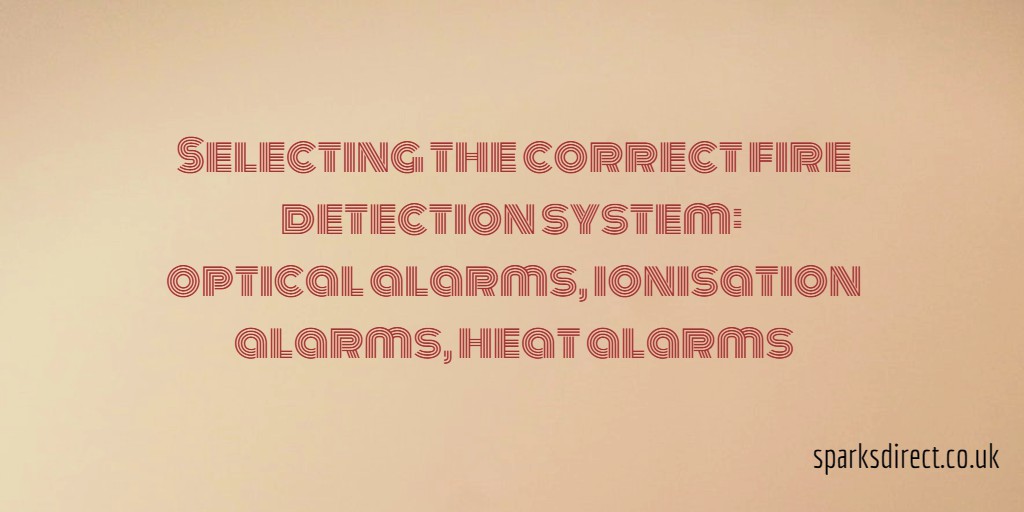Types of Fire Alarms - The Optical Alarms
The optical sensors are more responsive to smouldering fires producing large particle smoke typical of fires involving furniture and bedding.They are more immune to invisible smoke produced by 'burning the toast' and similar cooking fumes. This makes them ideal for siting in hallways close to kitchens where false alarms from ionisation alarms may be a particular problem.
The BS 5839: Pt.6: 2004 Standard recommends the use of optical alarms in circulation spaces of a dwelling, such as hallways and landings.
Optical alarms are prone to false alarm if exposed to steam and should not be located too close to poorly ventilated bathrooms or shower rooms. Examples of Aico Optical Alarms: the Aico Ei146 and Aico Ei166RC.
How do the optical alarms work?
- A light beam is pulsed in the sensor chamber every 10 seconds to ‘look’ for smoke. Any smoke present has to be visible to the naked eye so that the receptor can ‘see’ it. If no smoke is detected, the alarm will remain in a standby state.
- Using the light scattering principle when large particle smoke is detected, the light beam will be scattered onto the light receptor or using the obscuration principle when sufficient number of large particles of smoke are detected and prevent the light beam reaching the receptor.
- This will then send an electrical signal to the IC (Integrated Circuit).
- This causes the alarm to sound.
Types of Fire Alarms - The Ionisation Alarms
The ionisation type sensors are particularly sensitive to the almost invisible smoke produced by fast flaming fires. This makes them more liable to false alarm due to cooking fumes if sited in a hallway close to a kitchen.Ionisation alarms are less vulnerable to false alarms caused by dense tobacco smoke, excessive dust and insect ingress.
The BS 5839: Pt.6: 2004 Standard recommends that ionisation alarms should not be used in hallways and landings, where there is a risk of false alarms caused by cooking fumes.
Example of Aico Ionisation Alarms - the Aico Ei141.
How does the Ionisation Alarm work?
- Inside the sensor chamber is a minute (safe) radioactive element that ionises the air within. This causes a small current to flow in the chamber and this will remain constant for the life of the alarm unless smoke particles enter.
- When smoke enters the sensor chamber, the balance of the current is disturbed.
- This is detected by the electronics in the alarm circuitry and a signal is sent to the Integrated Circuit (IC).
- This causes the alarm to sound.
Types of Fire Alarms - The Heat alarms
The heat sensors are less likely to cause false alarm problems as they are not responsive to any type of smoke or fumes, only heat. Because of the potential for a slower response than smoke alarms, they should only be used in a fire alarm system that also includes smoke alarms, and all of the alarms must be interconnected.The BS 5839: Pt.6: 2004 recommends that heat alarms should be used in kitchens. It goes on to suggest that they may also have a role to play in the main living room but they should not be installed in circulation spaces or areas where fast response to fire is required.
Example of Aico Heat Alarms - the Aico Ei144.
How does the Heat Alarm work?
- A thermistor (a heat sensitive resistor) is sited in the sensor chamber of the alarm.
- When the temperature raises the resistance of the thermistor reduces.
- The IC continuously monitors the resistance of the thermistor. When this indicates the temperature is 58ºC or over, the IC sends a signal to the sounder circuit.
- The alarm then sounds.
Types of Fire Alarms - The Multi-Sensor Alarm
The Multi-Sensor combines the best features of an optical alarm – quick response to slow smouldering fires and immunity to kitchen fumes, with the best features of a heat alarm – quick response to a fast flaming fire and immunity from contamination.This makes it the ideal choice for all rooms in a dwelling except a kitchen. The Multi-Sensor alarm is less prone to contamination and effectively eliminates the problems of nuisance alarm associated with the ionisation and the optical type alarms.
Example of Aico Multi-Sensor Alarm - the Aico Ei2110.
How does the Multi-Sensor Alarm work?
- A custom algorithm written into the integrated circuit monitors and interprets the signal from: - An ultra fast temperature sensor and - A high performance optical sensor.
- This combination allows detection of both fast flaming and slow smouldering fires.
- This means the alarm will respond quickly to a wider range of fire types than any of the other individual sensor types.




